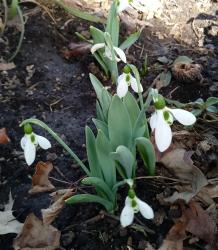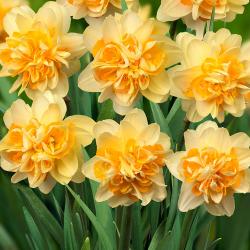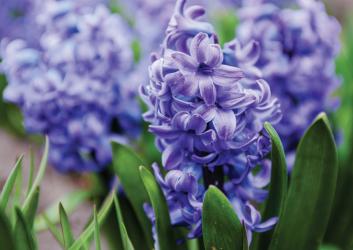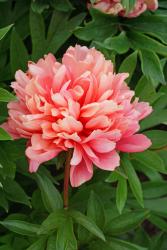A top choice for peony lovers is Lorelei. It starts its magnificent metamorphosis with cherry-colored buds tinted with a bit of orange. Buds open to wonderfully fragrant, massive, 10-inch orange flowers. You’ll be mesmerized with the magical transformation of the flowers as the petals become apricot colored, pink, then finally soft cream. Peonies grow many of their roots in the cooling soils of fall. If the eyes are planted too shallow or too deep, they may not flower. This is the most common mistake made when planting peonies and is most often the reason that peonies fail to flower. Plant peony roots in soil that has been amended with organic matter in full sun to light shade. Morning sun with light afternoon shade is ideal. The spring after they are planted, after flowering, fertilizer with an all purpose fertilizer. This will give them the energy they need to recuperate from blooming and keep a healthy root system. Ann Lapides, Sugar Creek Gardens.
Daffodils (or Buttercups as they're commonly known) naturalize very well in our area and so over the years they multiply and can be split and shared. We generally have pretty good moisture during the fall and winter, but if we go through a drought period, you definitely want to supplement some water here and there. The best thing you can do for spring bulbs is to let them get absolutely ragged looking before you cut back the foliage. They absorb all of the life and energy through their leaves for the following year during the time after they bloom. The leaves will get yellow and then brown, and at that time you can trim them all the way back. A light fertilizer of bone meal or Bulb-Tone goes a long way and can be used before they bloom when the leaves are just coming up and then after they bloom to create a good energy reserve for the following year. Laura Hill, Frisella Nursery.
Hyacinth bulbs are some of the easiest bulbs to plant.They look a bit like onions, with roots growing out of the bottom and a spike growing from the top. Plant hyacinths in the fall once ground cools in early November using Espoma Bulb Tone Fertilizer. Hyacinths come in a rainbow of colors and should be planted with root side down, covering top of bulb with 4-5” of soil. Water after planting and you will enjoy the early fragrant blooms in March. After the bulb blooms let the leaves grow until they are yellow, then cut back and leave them alone in your garden. Refertilize in fall and enjoy the blooms the following Spring. David Sherwood, Sherwood’s Forest Nursery.
Our favorite bulb provides the earliest of blooms: Galanthus woronowii, also known as Snowdrops since they often push up through the snow in late February. Like tiny white lanterns on short, curving green stems they are wonderfully perennial, rabbit and deer resistant and gently colonize both sun and shade gardens. Unlike most bulbs, they are best planted as soon as you get them and don’t need protection from pesky squirrels and voles. Set them out in clumps or drifts, 4 inches deep, and about 10-12 per square foot. Water them in and you are done – no need for fertilizer, supplemental watering or deadheading. Kathie Hoyer, Bowood Farms.
There are so many types of tulips to match so many styles. From solid-colored tulips, to multi-color and from traditional petals to ruffled and textured petals, there is a tulip out there for everyone! The larger the bulb, the deeper the planting requirement. For some of the larger bulbs (tulip, daffodil, Allium) we recommend about 6 inches of planting depth. This will help to keep the bulb from uprooting due to freeze/thaw cycles. Avoid overly wet areas. If the soil is overly dry, water after planting. Generally, Mother Nature will provide enough water after planting in the transition zone. For tulips, once the blooms are spent, cut the seed heads but leave the foliage in place. This can help encourage blooming the following year. Andria L. Graeler, Chesterfield Valley Nursery













